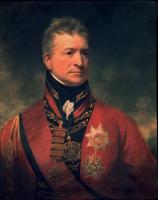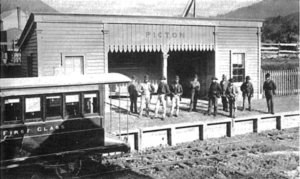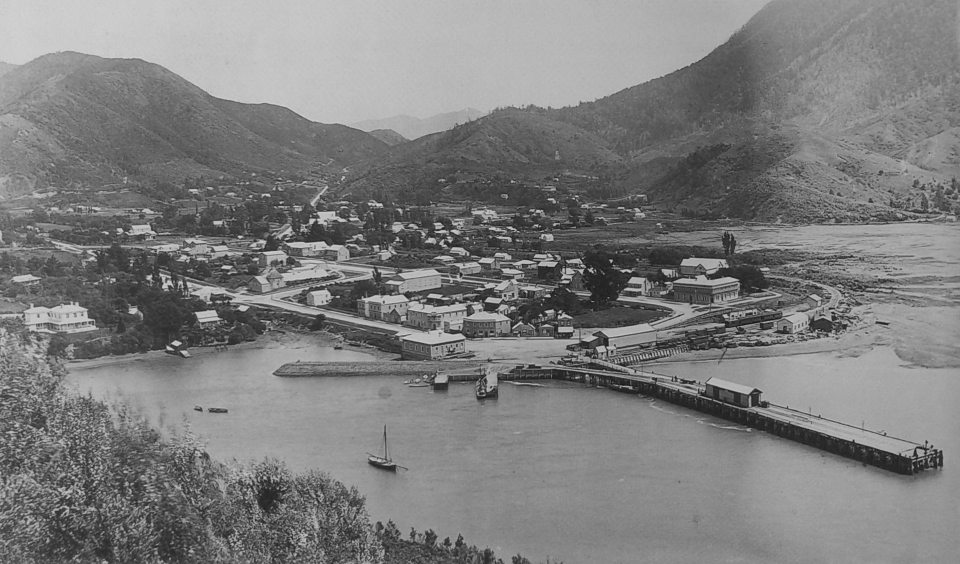One of a series of simple, easy to find, caches at railway stations in and around Marlborough.
Welcome aboard the Picton-Blenheim train service to Blenheim! Start of the line, next stop Elevation.
Newton
Newton township was surveyed in 1840, and in 1844 the purchase of the Waitohi land from the local Te Atiawa Maori was completed. In 1859 Newton was renamed Picton after Lieutenant-General Sir Thomas Picton (1758-1815).
Sir Thomas Picton
|
Sir Thomas was one of twelve siblings, born in Pembrokeshire , Wales, of Thomas and Cecil Picton. At age 15, he entered the army in Gibraltar as an ensign and just three years later was made captain. After a twelve year retirement at his father's estate in Britain Picton rejoined the army in 1794 in the West Indies shortly after was promoted to Major. While stationed at Trinidad in 1797 he was made Governor of the island, to protect it against reclamation by Spain. However reports of brutality, land and slave speculation and that his mistress was influencing his decisions led to demands for him to be recalled.
In 1803 Picton was arrested by the Privy Council for excessive cruelty and execution of suspects without due process, however he was able to successfully argue that the state of marshal law at the time justified the actions. Four years later he was arrested again, on a misdemeanor charge of torturing a young woman. Picton was found guilty but sought a retrial where again he successfully argued his release, on the grounds that torture was a legal and acceptable practice under Spanish law at the time, and that the torture had been requested by the local magistrate. Picton went back to the army. His successes in a number of battles in Spain against Spanish and French forces led to him receiving the G.C.B. in 1815. By then he had received the thanks of the House of Commons seven times and been promoted to lieutenant-general.
|

Sir Thomas Picton
|
Picton died in the Battle of Waterloo, the most senior officer to die there. He fought in civilian clothes with top hat, as his luggage had not yet arrived. His body is interred in St Paul's Cathedral.
Picton
In 1850 roads and cars did not exist and shipping was the primary means of transport. Overland routes into Canterbury and Nelson and what would become St Arnaud were found, and sheep numbers were building. Marlborough separated from the Nelson Region in 1859 and in its very second session a proposal for a rail way to Blenheim was raised. Although the motion was passed, the loan required to build it needed government support which was denied, possibly due to a lack of funds, but also to parochial in-fighting - Blenheim feared the loss of its river port, should Picton become the principal port into Marlborough. By now the bridle track to Blenheim was complete, with a ferry across the Wairau River and a bridge over the Opawa. The total population of Marlborough at the time was 2300 (this is probably census data, which did not include Maori). A second railway proposal was raised in 1863, this time with better arguments concerning freight expectations (especially timber), relief of the unemployment due to the collapse of the Marlborough gold rush. The opponents argued that a good dray road was cheaper. And when trying to get loan approval through government, the government sided with the opponents, claiming that "the relief of destitute persons is not a proper subject for a loan". Attempt number 3 succeeded in 1865 with approval for a loan for £80,000. In 1866 Mr L Wrey left for London to secure construction of the line and absconded with the £1000 advance. The debacle swung opinion to the opponents and the rail line was not built.
The petty squabbling between Blenheim and Picton was repeated all over the country when railways were discussed - after all, they are a VERY expensive item. Julius Vogel, the Colonial Treasurer, realised a central approach was needed to improve infrastructure. In 1870 he proposed and was given approval to raise a £10M loan for public works around the country, of which over £8M was to be spent on railways, construction of which would solve unemployment and be supplemented by immigrants brought in for the task. In the South Island his dream was to connect Picton to Bluff, Nelson, Westport and Hokitika.
The Railways Act of 1871 authorised the expenditure of £80,000 for the Picton and Blenheim Railway (after all, it was still on the books as approved since 1865) as the first component of a Picton to Christchurch railway. The contract was signed with John Brogden and Sons, of London, in August 1872. The line was opened on 18th November 1875. Population of Blenheim and Picton and the area between - about 6,000. In the first full year of operation 21,267 passengers (an average of 58 per day, but initially trains did not run daily) and 12,230 tons of freight and 562 head of livestock. This is despite that the line stopped two kilometres short of Blenheim, on the wrong side of the Opawa River.
At that time Picton Station was right on the waterfront, and the old platform is still present, painted blue at the time this cache was placed. It extends to either side of the cenotaph steps. The rail yards between it and the water were built on reclaimed land, partly to provide a goods loading wharf. Within 20 years a railed wharf was built where the water taxis operate now to improve shipping access - see photo below. Picton township expanded, and another railed wharf was built where the ferry terminal is now in 1912. Picton Station was replaced by a grander building in the current location in 1920. The car and rail ferries arrived in 1962.
The cache is hidden by the old men's toilets. A building under the road!
|

Picton Station, 1875
|
|

Picton about 1895. Passenger cars lined up at the station.
References:
theprow.org.nz: "Sir Thomas Picton and the naming of Picton"
wikipedia.org: "Thomas Picton"
Marborough Express, 12 September 1903
Merrifield, R: "Beyond Dashwood", published by the New Zealand Railway and Locomotive Society, 1990
McGavin, T.A.: "A Century of Railways in Marlborough 1876-1976", published by the New Zealand Railway and Locomotive Society, 1977.
Churchman, G & Hurst, T: "South Island Main Trunk 1992", published by IPL Books, 1992.
"The Picton Railway Act, 1861", Nelson Examiner and New Zealand Chronicle, 23 October 1861
Supporting the GeoKids program - my caches have treasure, makes them fun for kids to find!